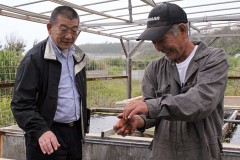Head of Iwaki Fisheries Cooperative studies sea urchin breeding in Okinawa

On April 5, Takeshi Ganeko, a member of the Okinawa Prefectural Collector Breeding Business Union (right) and Kazuyoshi Suzuki who came to learn land-based breeding techniques.
April 14, 2013 Ryukyu Shimpo
In Iwaki, Fukushima Prefecture, the tsunami that followed the Great East Japan Earthquake destroyed the port facilities and the radioactive leaks from the Fukushima-1 plant damaged the fishing grounds.
Kazuyoshi Suzuki, the head of the Iwaki Fisheries Cooperative, and someone who used to catch northern sea urchin, has started to try land-based breeding of Okinawa collector sea urchins in Tohoku after learning breeding techniques from the Okinawa Prefectural Collector Urchin Breeding Business Union in Uruma.
There are many challenges but, “We can’t just stand still,” says Suzuki. Northern sea urchin served on top of surf clam was a famous dish in Iwaki, but now it is hard to find. Everything was washed away by the tsunami, the ground level dropped in eleven places and because the sea is affected by radiation reconstruction for the fishing ports is still a distant goal. Only trial operations are possible at the moment. Even so, Suzuki has not given up on the reconstruction.
The Okinawa Industry Support Center introduced him to the business union, which breeds collector urchins and releases them in the sea around Okinawa.
Because the Iwaki Fisheries Cooperative has not used any breeding techniques this was an innovative idea for them. It takes five to eight years to breed the northern sea urchin but just a year or so for the collector sea urchins in Okinawa. Suzuki wants to try to stop union members from leaving the fishing industry to look for land-based jobs because the compensation paid by Tokyo Electric Power Company for loss of income is not enough to live on.
Suzuki visited Okinawa on April 4 and was taught about breeding techniques by Takeshi Ganeko, a member of the union who is in charge of the process. The business union is seeking to obtain cooperation from Uruma in order to expansion of its breeding facilities, and wants to support Suzuki for the sake of the reconstruction of Tohoku.
However, staff of the Okinawa Cultural Fishery Center have suggested that this is unrealistic because while breeding collector sea urchin works in a temperate region, it will not in Tohoku, which is a cold region. There are many challenges and the cost of feeding and maintaining the water temperature is very high. On top of that, Suzuki still needs to get the conservative Iwaki Fisheries Union to understand the new breeding process.
Be that as it may, Suzuki said, “We still need to try to do what we can do.” Many people died in the earthquake and survivors were forced from their homes because of the nuclear accident. The radiation has polluted the seawater, and the presence or absence of compensation from the Tokyo Electric Power Company and the difference in the amount of such payments has affected people’s relationships, with them often becoming awkward and complicated. Suzuki said, “Because of these challenges, I want to work hard to reconstruct the community through the fishing industry. When it succeeds, it will be a great opportunity to link Fukushima with Okinawa that has provided support for us.”
(English translation by T&CT, Hitomi Shinzato and Mark Ealey)
Previous Article:New breed of orchid discovered in Takae district of Higashi
Next Article:Fisheries Agency announces patrol vessel on constant deployment at Miyako
[Similar Articles]
- Sea urchins found to grow rapidly when raised with Shimaguwa leaves, and the Urasoe Ginowan Fishery Cooperative is looking to capitalize
- Typhoon Sanba causes 397 million yen in crop damage
- Okinawa accepts technical intern trainees from Indonesia
- Disappointment in Okinawa after unsuccessful Taiwan-Japan fishery talks
- Okinawa Defense Bureau to compensate Nago Fisher’s Union with 3.6 billion yen
 Webcam(Kokusai Street)
Webcam(Kokusai Street)


